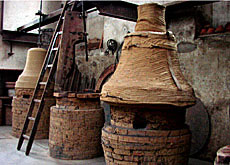
600 years of Christmas bells

Church bells ringing in Christmas around the world is a tradition unchanged over the centuries.
Among them are hundreds of bells from the Rüetschi foundry in Aarau in northern Switzerland, which has been casting bells since the 14th century.
One of the firm’s progeny, “Barbara”, who weighs in at a hefty 2,000 kilograms, will ring in her 636th Christmas at Fribourg Cathedral.
Engraved on “Barbara” in Latin are the words: “Cast in the year 1367, in the month of October, by Walter Reber of Aarau”.
This bell-making tradition still continues at the Aarau foundry, passing on uninterrupted through generation to generation. Today, the firm produces around 20-30 church bells a year.
And while other foundries exist in Switzerland, none of them makes church bells any longer.
“Bronze foundry workers were once spread right throughout Europe,” explains René Spielmann, director of Rüetschi. “Bell-making came from Ireland between the 8th and 9th centuries.”
Competition now comes from France, Germany and Italy, but Rüetschi continues to export its bells – as it has done for hundreds of years.
“Made in Aarau” bells sound in Europe, Latin America, the United States, Ghana and the Philippines.
Lost in time
A visit to the foundry workshops, situated not far from Aarau station, is rather like taking a step back in time; perhaps not back to the Middle Ages, but certainly to the start of the 19th century.
The giant bells are made much as they always have been: first, you build a brick core, reinforced with copper and wire, which is then covered in tallow; then, a “false bell” is made with more tallow; and finally, the casing is slipped on using further layers of tallow and clay.
Once these three stages have been completed, the bell form is transported to the foundry pit and the “false bell” removed, creating a space into which molten metal (79 per cent copper and 21 per cent tin) is poured.
The brick core moulds the inner surface of the bell, while the casing shapes the outside. It is a technique that has stood the test of time.
Nowadays technology – in the form of a computer – plays a part in calculating dimensions, and electronic frequency measuring equipment is used to precision tune the bells.
Hitting the right note
It’s worth noting that a bell doesn’t have just one note, but a main tone plus a series of harmonic overtones. The choice of tone usually depends of the client’s wishes or, more often, the bell’s future home.
It should fit in with its acoustic surroundings: the other bells in the belfry and those in nearby churches, without upsetting the harmony.
“A bell is a musical instrument,” says Spielmann. “There is the bell itself, but also a resonance chamber, which is the bell tower, and the beam that holds the bell. All these elements make up the instrument.
“It is the whole, and the good maintenance of all the component parts, which guarantees a precise tone and the acoustic quality.”
swissinfo
Rüetschi in Aarau is the only foundry in Switzerland which still makes church bells – and it has been doing so since the 14th century.
The firm uses traditional methods to produce 20-30 church bells a year.
The heaviest bell ever cast by Rüetschi weighed 8,695kg and hangs in the Catholic church in Gossau.
Up until 1869, the foundry also made cannon.

In compliance with the JTI standards
More: SWI swissinfo.ch certified by the Journalism Trust Initiative



























You can find an overview of ongoing debates with our journalists here . Please join us!
If you want to start a conversation about a topic raised in this article or want to report factual errors, email us at english@swissinfo.ch.